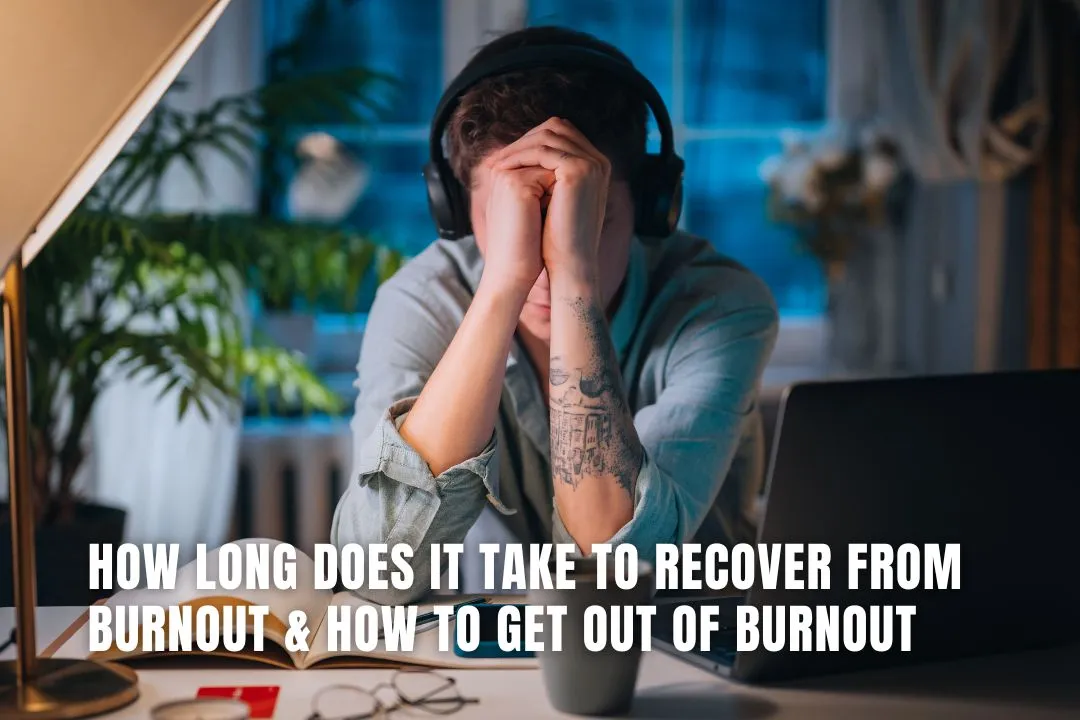
Burnout is a complete shutdown of your drive, energy, and focus. It is not just feeling exhausted. How long does recovery take, then? Will you ever be able to feel like yourself again? When rest is not enough, this article explains the science behind recovery timelines, what slows you down, and what actually works.
Burnout is more than just feeling worn out from a demanding week. This condition is characterised by persistent physical and emotional fatigue brought on by stress, frequently from work or caregiving responsibilities. It can seriously affect immune system performance, motivation, and cognitive functioning.
According to the World Health Organisation (WHO), burnout is classified as an “occupational phenomenon” and includes three key components: energy depletion, mental distance from one’s job, and reduced professional efficacy.
Although it is frequently linked to toxic workplaces, burnout is more widespread than that. The Job Demands-Resources (JD-R) model states that burnout happens when an individual's emotional, social, and physical resources are continuously outweighed by the demands placed on them.
Typical reasons include:
Burnout takes time to develop. Usually, it progresses in phases:
Burnout develops over time and does not go away with a weekend getaway, in contrast to acute stress, which may go away after a deadline. Some people may feel better in a few weeks, while others may not fully regain their energy, focus, and emotional balance for months or longer.
The length of time the burnout has lasted, the intensity of the symptoms, and whether noteworthy adjustments have been made to the stressors that caused it are some of the factors that influence the large variance.
According to studies, recovery from mild burnout, where symptoms are recognised early and lifestyle changes are made quickly, can be within 3 to 6 weeks. For those who are experiencing moderate to severe burnout, however, recovery could take months or even years, particularly if it has been ongoing for months or years.
A longitudinal study published in the Journal of Occupational Health Psychology found that full emotional and cognitive recovery from chronic burnout often requires 6 months or more, particularly when symptoms include depersonalisation and cognitive fatigue. Recovery is not just about “resting” but rebuilding resilience at multiple psychological, physiological, and relational levels.
Every burnout situation is unique. The way two people in the same job experience burnout can vary greatly depending on their neurobiology, emotional coping mechanisms, trauma history, and personal expectations.
Moreover, the term "recovery" can mean several things:
Yes, burnout is recoverable. But full recovery doesn’t mean “getting back to how things were.” Returning to the same environment, habits, or mindset that led to burnout is one of the strongest predictors of relapse. Real recovery is more about changing your relationship with work, stress, and self-worth than getting back on your feet.
A return to peak productivity is a common misconception about recovery. However, those who have recovered from burnout have a different description of the procedure:
Not only symptom relief but also a wellbeing app and lifestyle changes are part of this. One might, for instance, cut back on their working hours, change careers, or set more rigid boundaries with those who used to drain them.
While there’s no instant fix for burnout, some strategies can significantly accelerate recovery. These aren’t just self-care tips. They're grounded in what research shows helps the nervous system reset, the brain restore executive function, and the body regain energy after long-term stress exposure.
Burnout isn’t a personal failure, and it’s a physiological and psychological response to prolonged, unmanaged stress. According to Dr. Christina Maslach, acknowledging burnout is the first real turning point in recovery. People often delay healing by minimising their symptoms, blaming themselves, or continuing to “push through.”
Admitting burnout isn’t weakness; it’s clarity. And that clarity is necessary to make meaningful changes.
While sleep and time off are essential, passive rest alone isn’t enough to reverse burnout. According to studies, taking deliberate, active steps to recover, boost energy, and manage stress is more beneficial than doing nothing at all.
Examples of active recovery:
Changing the definition of "enough" is one of the hardest but most important steps. The majority of burnout sufferers have internalised notions that associate productivity with self-worth. If this mindset is not challenged, burnout recovery will only last a short time.
Strategies include:
This is known as "resetting your internal bar," according to burnout researcher Dr. Marie Asberg. When you go back to the same high-demand, low-recovery cycle, symptoms can reappear.
You don’t have to recover alone, and doing so often slows the process. Therapy, coaching, or even structured peer support can help you process what led to burnout and rebuild a healthier internal framework.
It has been demonstrated that therapies such as Compassion-Focused Therapy, Acceptance and Commitment Therapy, and Cognitive Behavioural Therapy (CBT) enhance emotional regulation and lessen the symptoms of burnout. Additionally, talking to people who have gone through burnout can help normalise the experience and reduce feelings of shame. Shared experience fosters hope.
How many changes a person can realistically make and how quickly they can do so will determine how quickly they recover from burnout. Among the major influences are:
For instance, a person who starts therapy and takes a planned sabbatical from work might recover more quickly than someone who stays in the same position without any coping mechanisms or emotional support.
Recovery from burnout does not happen on a set timetable. The multi-layered process includes rest, introspection, and redefinition; it is not just a question of willpower or taking a few days off. Recovery might start in a few weeks for some people. Some people, particularly those who have severe or chronic burnout, may need months or even longer. More important than how quickly you recover is whether you return differently.
It is best not to become the person you were before burnout. Rebuilding a more sustainable life that aligns more with your values and is less likely to compromise your health is the aim, not merely getting better.